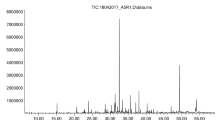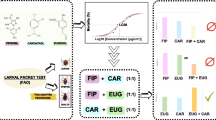Abstract
The aim of this study was to evaluate the influence of different doses of Heterorhabditis amazonensis RSC-5 on the biological parameters of engorged females of Rhipicephalus (Boophilus) microplus. The female ticks, individually identified, were divided into six groups of 20 each and exposed to the following nematode concentrations: 0, 75, 150, 300, 600, and 1,200/female. The following parameters were observed: initial weight, final weight, alteration weight, egg mass weight, pre-oviposition period, oviposition period, survival period, incubation period, hatching percentage, reproductive efficiency index (REI), nutritional efficiency index (NI), and percentage of control. There were no significant differences observed for the initial weight, pre-oviposition period, incubation period, and NI (p > 0.05) between the various treated groups and the control group. However, there were significant differences (p < 0.01) for the oviposition and survival periods between all the treated groups and the control group. For the final weight, alteration weight, egg mass weight, and REI, only the treatment with 1,200 nematode/female did not differ significantly from the respective figures for the control group (p > 0.05). The highest control rate was 67.8%, obtained in the treatment with a concentration of 300 entomopathogenic nematodes/female. The results demonstrate that this nematode has a deleterious effect on the majority of the biological parameters analyzed.

Similar content being viewed by others
References
Andaló V, Nguyen KN, Moino-Jr A (2006) Heterorhabditis amazonensis n. sp. (Rhabditida: Heterorhabditidae) from Amazonas, Brasil. Nematol 8:853–867
Bennett GF (1974) Oviposition of Boophilus microplus (Canestrini, 1887) (Acarina: Ixodidae): influence of tick size on egg production. Acarol 16:52–61
Borges LMF, Carneiro JR, Gomes AG, Moreira PC (2001) Influência do peso inicial e da estação do ano na conversão em ovos de fêmeas de Boophilus microplus (Acari: Ixodidae). Cienc Animal Bras 2:127–131
Dolinki C, Moino-Jr A (2006) Utilização de nematóides entomopatogênicos Nativos ou Exóticos: O Perigo das Introduções. Nematol Bras 30:139–149
Dolinski C (2006) Uso de entomopathogenic nematodes para o controle de pragas. In: Venzon M, Paula Jr TJ, Pallini A (Org.) Tecnologias Alternativas para o Controle Alternativo de Pragas e Doenças, Viçosa, pp 261-289
Drummond RO, Ernest SE, Trevino JL, Gradney WJ, Graham OH (1973) Boophilus anulatus and Boophilus microplus: laboratory tests of insecticides. J Econ Entomol 66:30–133
Freitas-Ribeiro GM, Furlong J, Vasconcelos VO, Dolinski C, Ribeiro AL (2005) Analysis of biological parameters of Boophilus microplus Canestrini, 1887 exposed to entomopathogenic nematodes Steinernema carpocapsae SANTA ROSA AND ALL STRANIS (Steinernema: Rhabditidae). Braz Arch Biol Technol 48:911–919
Furlong J, Martins JRS, Prata MCA (2004) Controle estratégico do carrapato dos bovinos. A Hora Vet 23:53–56
Furlong J, Martins JRS, Prata MCA (2007) O carrapato dos bovinos e a resistência: temos o que comemorar? Controle estratégico do carrapato dos bovinos. A Hora Vet 27:53–56
Grisi L, Massard CL, Moya-Borja GE, Pereira JB (2002) Impacto econômico das principais ectoparasitoses em bovinos no Brasil. A Hora Vet 21:8–10
Kaaya GP, Samish M, Glazer I (2000) Laboratory evaluation of pathogenicity of entomogenous nematodes to African ticks species. Ann N Y Acad Sci 916:306–308
Kaya HK, Stock P (1997) Techniques in insect nematology. In: Lacey LA (ed) Manual of techniques in insect pathology. Academic, CA, pp 281–324
Klafke GM (2008) Resistência de Rhipicephalus (Boophilus) microplus aos carrapaticidas. In: Pereira MC, Labruna MB, Szabo MPJ, Klafke GM (eds) Rhipicephalus (Boophilus) microplus: Biologia, Controle e Resistência. MEDVET, São Paulo, pp 65–80
Lindegren JE, Valero KA, Mackey BE (1993) Simple in vivo production and storage methods for Steinernema carpocapsae infective juveniles. J Nematol, Florida 5:93–197
Pereira MC, Labruna MB (2008) Rhipicephalus (Boophilus) microplus. In: Pereira MC, Labruna MB, Szabo MPJ, Klafke GM (eds) Rhipicephalus (Boophilus) microplus: Biologia, Controle e Resistência. MEDVET, São Paulo, pp 15–56
Reis-Menini CMR, Prata MCA, Furolng J, Silva ER (2008) Compatibility between the Entomopathogenic nematode Steinernema glaseri (Rhabditida: Steinernematidae) and an acaricide in the control of Rhipicephalus (Boophilus) microplus (Acari: Ixodidae). Parasitol Res 2:1391–1396
Santos AP, Furlong J (2002) Competição intraespecífica em Boophilus microplus. Cienc Rural 32:1033–1038
Silva E (2007) Ação do nematóide entomopatogênico Heterorhabditis indica LPP1 (PONIAR, KRANUKAR & DAVID, 1992) (RHABDITIDA: HETERORHABDITIDAE) sobre a biologia reprodutiva de fêmeas ingurgitadas de Boophilus microplus (CANESTRNII, 1887) (ACARI: IXODIDAE). Dissertation, Universidade Federal de Juiz de Fora, Minas Gerais, Brasil
Vasconcelos VO, Furlong J, Freitas GM, Dolinski C, Aguillera MM, Rodrigues RCD, Prata MCA (2004) Steinernema glaseri Santa Rosa strain (Rhabditida: Steinernematidae) and Heterorhabditis bacteriophora CCA strain (Rabditida: Heterorhabditidae) as biological control agents of Boophilus microplus (Acari: Ixodidae). Parasitol Res 94:201–206
Author information
Authors and Affiliations
Corresponding author
Rights and permissions
About this article
Cite this article
de Oliveira Monteiro, C.M., de Azevedo Prata, M.C., Furlong, J. et al. Heterorhabditis amazonensis (Rhabditidae: Heterorhabditidae), strain RSC-5, for biological control of the cattle tick Rhipicephalus (Boophilus) microplus (Acari: Ixodidae). Parasitol Res 106, 821–826 (2010). https://doi.org/10.1007/s00436-010-1720-6
Received:
Accepted:
Published:
Issue Date:
DOI: https://doi.org/10.1007/s00436-010-1720-6




